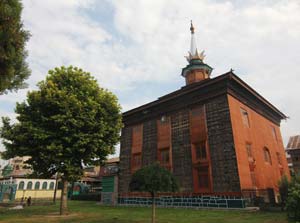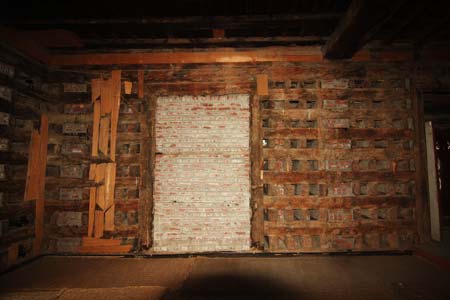A senseless human intervention is threatening the existence of a 16th century heritage structure in saffron town of Pampore. The building has lost its architectural grandeur and a sense of spirituality which it brought to the faithful, SHAMS IRFAN reports.
Squeezed between the newly constructed residential houses on one side and the shrine of Khawja Masood Wali on the other, Khanqah-e-Pampore, a 16th century wood and mud structure fades in the gaudiness of the landscape. As one walks past the arched stone gates of Khanqah, an overdone and colourful store room catches your eye. The room is almost carved out of one corner of centuries-old heritage Khanqah building.
Like a big black spot, the room appears to mock at the people for their inability to preserve their history and heritage. A semi-octagonal brick and stone structure which can be accessed from the front porch of the Khanqah is closed throughout the year, except during special religious functions when the relics of Khawjah Masood Wali are displayed to public through its windows.
The room is said to be the brainchild of Idarah Auqaf Islamia Trust, Pampore (IAITP), a local body whose sole aim is to preserve and protect the historical Khanqah. Over the last 70 years, Khanqah in Pampore has been under the supervision of IAITP, which took birth under the patronage of late Mirwaiz Mohammad Yasin Hamdani and is currently supervised by his son, Molvi Riyaz Hamdani.
“This room was constructed when I was a kid. All the relics of Khawaja Masood Wali shrine are kept there for display,” said Altaf Ahmad Shah, former Secretary of IAITP.
On the opposite side of the store room, there is a spacious staircase which opens up to the second story of the Khanqah. The big dark staircase which looks like an inferior attachment to the Khanqah was constructed after demolishing the original spiral staircase which had lattice windows for lighting the inside of the building. “People used to feel dizzy while climbing those spiral stairs. So we constructed the fresh one,” said Mohammad Sultan Shah, Secretary General, IAITP.
The main structure which is mostly made of wood and filled with bricks and

mud, have three vertical rows of windows on both northern and southern sides of the structure. The original lattice windows were replaced with glass windows. However the windows on the second floor were permanently shut using bricks and cement. “It looks like an Army bunker from outside,” said an old man who was taking siesta in the garden outside the Khanqah.
As you walk around the tall wooden structure, one could not help but notice the heartlessness with which the administration that was supposed to maintain and take care of the Khanqah has helped in bringing doom to this structure.
The senseless vandalism of this heritage Khanqah almost instantly breaks your heart. But, at the same time, it somehow prepares you for the worst that you are about to witness.
Some years back, the mud filling in the external walls of the Khanqah was replaced and filled with cement and modern bricks. “Of course the previous management has consulted experts before starting the renovations,” said Shah. But locals allege that IAITP never took any expert advice before renovating the historic structure. “They (IAITP) only consulted a local electric engineer and it was on his advice that the original mud filling was replaced with cement and bricks,” said a local historian who wished not to be named. “Cement shortens the life of wood. It will prove disastrous for the structure,” said Prof GM Bhat, Registrar, University of Jammu and a professor of Geology, who visited the Khanqah two years back with a London based heritage expert.
Around 20 years back, the then administration of Khanqah proposed to build three large minarets on the front side of the structure. One can still see the incomplete bases built next to the wooden front wall of the structure. “Thank god, the project never took off otherwise it would have completely dwarfed the architectural grandeur that this Khanqah is famous for,” said Bhat.
The entire front side of the Khanqah is covered with rust coloured fibre sheets. It covers the original look of the Khanqah and also threatens the structure. “It is to protect the structure from rains,” said Shah. The entire Khanqah is painted in rust colours making the grand old structure look dull and lifeless.
Once inside the main prayer area, the newly attached false wooden roof and refurbished interiors fail to sync with the overall traditional look of the Khanqah. The high ceiling of the ground floor of the Khanqah is divided into two stories to make space for once-in-a-year religious congregation.

The new false roof made mostly out of cheap wood hides the original cedar structure. The interior of the Khanqah reminds you of some dingy three-star hotel in one of the many tourist hotbeds in Kashmir. “There is no spirituality left in this place,” said a local who has been visiting the Khanqah since his childhood. “It looks like a beautifully decorated houseboat from inside,” he added sarcastically.
Cheap wood has been used for panelling the walls and pillars in the main prayer hall, hiding the original cedars from admirers forever. Two new staircases were added on either side of main prayer hall entrance. The stairs open into a false ceiling that divides the ground floor into two stories. “As the space inside the Khanqah was not enough to accommodate everybody, we thought of adding one more storey,” said Altaf Ahmad. The Khanqah remains closed for all prayers except Eid and other special occasions. Khanqah, which was originally a double storied structure, struggle to adjust to this image makeover.
The Khanqah is believed to have been built in 16th century by Baba Mohammad Sadiq, locally known as Said Baab Sahab, who was a disciple of Khawaja Masood Wali. As there is no forest nearby, there are many myths attached with the procurement of wood for construction of the Khanqah. The most commonly believed myth is that the long logs of wood used in the construction of Khanqah were brought down by flooding Jhelum River that still flows half a mile away.
The structure has been redone so many times that one hardly remembers how it looked originally. “Unlike Khanqah-e-Maullah in Srinagar, this Khanqah fails to attract visitors because it lacks originality,” said a local. “IAITP is an independent trust run by locals. It has got nothing to do with Auqaf Islamia Kashmir. We select our member through elections which take place after every three years,” said Shah.
“Had it been kept in its true glory, the old Khanqah would have added to the beauty of the town,” said Mushtaq Ahmad Ganie, a local social worker. “But the people who are assigned to preserve the heritage vandalised the Khanqah,” he said.
“Heritage should have been preserved,” Prof. Bhat feels.

















Wonderful story. an eye opener. u should have clearely named these mallah’s who have ruined our heritage and culture and polluted our religion for their own gains….they consider these places as there property…we should have fought them instead of fighting India…(India we could have tackled next).
Thanks Kashmir Life…
Excellent piece, now demands some practical work.
Thanks
Kashmir Life and the writer